
Design Anthropology
As a transdisciplinary area of research and practice, Design Anthropology is not located in any one... View more
Design anthropology has come to be known as an area that is inclusive of every juncture at which the fields of design and anthropology have met, so that “design anthropology” has become a shortened form of “design (and) anthropology.” A useful framing of the diversity of meanings associated with “design (and) anthropology” was laid out by Gunn and Donovan in the introduction to the 2013 edited volume, Design and Anthropology. The authors utilized variously capitalized acronyms as a device to map the differently oriented positions and practices as progressive disciplinary advancements that culminate in a transdisciplinary form of "design (and) anthropology":
dA — The theoretical contribution is for anthropology rather than design. Design follows the lead of anthropology in terms of adopting theoretical understandings, or becoming the subject of anthropological study. Da — Fieldwork is in the service of design. Framing originates from problem-oriented design approaches rather than engagement with peoples. Anthropology is put in service of design, for example ethnographic studies are used for establishing design requirements. DA — Disciplines of design and anthropology are engaged in a convergence of efforts each learning from the other (Halse 2008). DA is a shift from informing design to re-framing social, cultural and environmental relations in both design and anthropology… (Gunn and Donovan 2012:8–9)
As this multifaceted definition of design anthropology demonstrates, the various orientations take on many diverse and distinct meanings when evaluated on the merits of their disciplinary positioning, research priorities, and methodological approaches. These are significant enough that it is necessary to take them into account in any definition of design anthropology and to identify what forms of theory and practice are derived from them. The existence of a transdisciplinary form of design anthropology as a distinct field is still debated, but there has been significant work at the intersection of anthropology, STS, actor-network theory and particular forms of design practice such as participatory design, codesign, speculative design, critical design, and decolonized design.
While both design and anthropology have in many ways always been multidisciplinary, emerging, critical, and alternative areas within design today are the result of a larger ecosystem of epistemologies that are all interacting, commingling, and diverging across design and other disciplines as active participants in the development of new transdisciplinary areas of theory and practice. For instance, emerging and proposed fields of design, such as transition design, pluriversal design, and ontological design hold many shared contributions with design anthropology.
Following Gunn and Donovan’s acronym-based distinctions, design anthropology is interpreted in this group as a mapping of the variously-oriented relationships formed between design, anthropology, and other intersecting fields as a heuristic device for anthropologists and designers to navigate each specific field in relation to their own, while a transdisciplinary form is taken more as an epistemological construct for exploring and experimenting with proposed forms of a more theoretically-entangled design practice. However, following Allison Clarke, such distinctions do not qualify as a commentary on the broader fields of anthropology or design, or automatically entitle design anthropology as a new (sub)field within either.
Reading List
Moving away from conceptions of design anthropology that equate it with user research practices in design(-as-business) or as the exclusive, yet blurring, domain of anthropologists, this reading list has been compiled with an understanding of design anthropology as (part of) an emerging, transdisciplinary design research practice. As such, I've organized the list to zoom in on the trajectory of these developments across anthropology and design.
 "Design for Development, ICSID and UNIDO: The Anthropological Turn in 1970s Design" by Alison Clarke in Journal of Design History Vol. 29 No. 1
"Design for Development, ICSID and UNIDO: The Anthropological Turn in 1970s Design" by Alison Clarke in Journal of Design History Vol. 29 No. 1
From the late 1960s to the close of the 1970s, anthropology and the social sciences coalesced with industrial design, transforming design from a practice whose aesthetic discourse was largely dominated by industrial rationalism, to one of critical intervention with a social agenda. First emerging as a grassroots ‘alternative design’ movement influenced by workers’ unions, design student activists and user-based research methodologies, the coming together of social science (more specifically anthropology) and design by the late 1970s evolved into formal policy within the international industrial design profession. Incorporating previously unexplored documentation of the International Council of Societies of Industrial Design (ICSID) and the United Nations Industrial Development Organization (UNIDO), this article examines the crucial dispersion of anthropology within design, and its culmination in the ‘Ahmedabad Declaration’ in 1979... The author considers how the informal ‘alternative design’ movement was incorporated into industrial design’s role in 1970s entente Cold War politics; highlighting how anthropological methodologies and considerations were key to securing the design profession’s prominence in newly emerging development policies and ‘soft power’ structures.
(also see Clarke's contributions on alternative histories of anthropology in design: "The New Design Ethnographers 1968–1974: Towards a Critical Historiography of Design Anthropology." in Design Anthropological Futures and "The Anthropological Object in Design: From Victor Papanek to Superstudio" in Design Anthropology: Object Cultures in Transition. See Otto and Smith, "Design Anthropology: A Distinct Style of Knowing" in Design Anthropology: Theory and Practice for a historical trajectory of developments from an anthropology perspective)
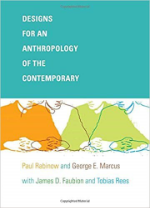 Designs for an Anthropology of the Contemporary by Paul Rabinow and George Marcus
Designs for an Anthropology of the Contemporary by Paul Rabinow and George Marcus
In this compact volume two of anthropology’s most influential theorists, Paul Rabinow and George E. Marcus, engage in a series of conversations about the past, present, and future of anthropological knowledge, pedagogy, and practice... Most of the conversations are focused on contemporary challenges to how anthropology understands its subject and how ethnographic research projects are designed and carried out. Rabinow and Marcus reflect on what remains distinctly anthropological about the study of contemporary events and processes, and they contemplate productive new directions for the field. The two converge in Marcus’s emphasis on the need to redesign pedagogical practices for training anthropological researchers and in Rabinow’s proposal of collaborative initiatives in which ethnographic research designs could be analyzed, experimented with, and transformed.
“A Cautious Prometheus? A Few Steps Toward a Philosophy of Design,” Keynote by Bruno Latour, Networks of Design, Design History Society
"If it is true as I have claimed that we have never been modern, and if it is true, as a consequence, that 'matters of fact' have now clearly become 'matters of concern', then there is logic to the following observation: the typically modernist divide between materiality on the one hand and design on the other is slowly being dissolved away. The more objects are turned into things – that is, the more matters of facts are turned into matters of concern – the more they are rendered into objects of design through and through."
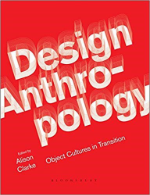 Design Anthropology: Object Cultures in Transition, 2nd edition edited by Alison Clarke
Design Anthropology: Object Cultures in Transition, 2nd edition edited by Alison Clarke
Decades ago, product designers used basic market research to fine-tune their designs for consumer success. Today the design process has been radically transformed, with the user center-stage in the design process. From design ethnography to culture probing, innovative designers are employing anthropological methods to elicit the meanings rather than the mere form and function of objects. This important volume provides a fascinating exploration of the issues facing the shapers of our increasingly complex material world. The text features case studies and investigations covering a diverse range of academic disciplines. From IKEA and anti-design to erotic twenty-first-century needlework and online interior decoration, the book positions itself at the intersections of design, anthropology, material culture, architecture, and sociology.
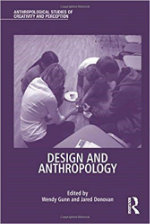 Design and Anthropology edited by Wenny Gunn and Jared Donovan
Design and Anthropology edited by Wenny Gunn and Jared Donovan
Design and Anthropology challenges conventional thinking regarding the nature of design and creativity, in a way that acknowledges the improvisatory skills and perceptual acuity of people. Combining theoretical investigations and documentation of practice based experiments, it addresses methodological questions concerning the re-conceptualisation of the relation between design and use from both theoretical and practice-based positions. Concerned with what it means to draw 'users' into processes of designing and producing this book emphasizes the creativity of design and the emergence of objects in social situations and collaborative endeavours. Organised around the themes of perception and the user-producer, skilled practices of designing and using, and the relation between people and things, the book contains the latest work of researchers from academia and industry, to enhance our understanding of ethnographic practice and develop a research agenda for the emergent field of design anthropology.
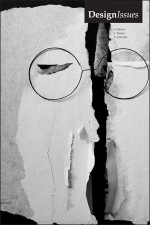 "The Logic of the Design Problem: A Dialectical Approach" by Stephen J. Beckett in Design Issues 33:4 (2017)
"The Logic of the Design Problem: A Dialectical Approach" by Stephen J. Beckett in Design Issues 33:4 (2017)
This article analyzes the logic of the design problem by using a Hegelian dialectical approach. It begins by identifying the logical paradox at the heart of the design problem and clarifying the method of dialectical logic, and then applies this logic to the design problem by demonstrating how problems and solutions emerge simultaneously as “moments” of a single concept. Finally, the designer's role as a “speculative reader” in the process is briefly considered.
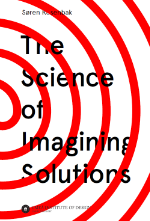 "The Science of Imagining Solutions: Design Becoming Conscious of Itself Through Design" by Søren Rosenbak (PhD Thesis)
"The Science of Imagining Solutions: Design Becoming Conscious of Itself Through Design" by Søren Rosenbak (PhD Thesis)
We can say that—distinct from other disciplines—design contributes knowledge through this very practice of possibilizing. Strangely, design displays a curious lack of consciousness of itself with respect to this unique capability, preferring to instead put its growing array of design methods and design thinking tool kits to use in the latest problem areas, thereby implicitly affirming the lack of any distinct knowledge contribution at its core. With a commitment to reverse this dynamic by exploring this very capability, this dissertation concerns the prototyping of a pataphysically infused design practice, as a way of making design more conscious of itself.
Teaching Everything in Relationship: Integrating Social Sciences and Design in Teaching and Professional Practice by Alvise Mattozzi in Diseña 12 (2018):104-125
The availability of social sciences courses in design schools does not automatically entail the integration of social sciences in design teaching. In order to achieve such integration, social sciences cannot be relegated to the task of providing information about the context in which design artifacts circulate. This contextual view of the social sciences is based on a ’regional topology’ of the social, which must be replaced by a ’network topology’ of the social, already enacted within design practice. Through a ’network topology’, the description of the relations to which artifacts take part emerges as the ground for collaboration between design and social sciences. Such ground for collaboration is key also for teaching social sciences in design schools. The introduction of two examples of assignments that consider the common ground of description concludes the article.
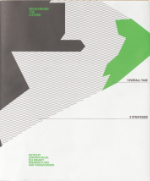 Rehearsing the Future edited by Joachim Halse, Eva Brandt, Brendon Clark, and Thomas Binder
Rehearsing the Future edited by Joachim Halse, Eva Brandt, Brendon Clark, and Thomas Binder
(free download) "A courageous manifesto for designers of the future, though not yet another futuristic one praising the force of new technology and rapid changes, but one acknowledging the power of the 'everyday' as a major force in design. Through a collage of programs, cases, challenges and resources a really inspirational design anthropological innovation model is outlined throughout the book. Celebrating design and participative and user-driven innovation as intertwined with the ongoing performance of the everyday, this is a performative manifesto for design as the here and now collaborative rehearsing of the future. This is a must have sourcebook for participatory design practitioners as well as a much needed manifesto to be inspired and challenged by." - Pelle Ehn, Professor, Malmö University
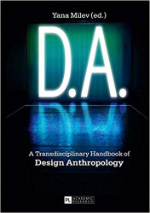 D.A.: A Transdisciplinary Handbook of Design Anthropology edited by Yana Milev
D.A.: A Transdisciplinary Handbook of Design Anthropology edited by Yana Milev
D.A. represents a cultural science handbook of Design Anthropology, providing an epistemology, phenomenology and survey of the varieties of the extended concept of design. Here the design concept is placed at the centre of the nexus of meaning of cultural production that rests on the three pillars Segno, Mythus and Techne. Anthropological design research is trans-disciplinary, developing in the connexion between Visual Culture (signal, in/visibility, image/void, imagination, representation), Doing Culture (act, cooperation, relation, fabrication, exchange), Material Culture (object, artefact, thing, facing, texture), Knowledge Culture (techniques, practices, norms, beliefs, values), Narrative Culture (mythology, significance, meaning, memory, identity), Critical Culture (watching, criterion, antagonism, crisis, theory) and Aesthetic Culture (emotion, sentiment, taste, feel, sense).
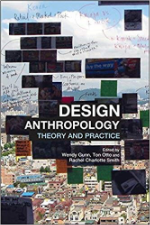 Design Anthropology: Theory and Practice edited by Wendy Gunn, Ton Otto, and Rachel Charlotte Smith
Design Anthropology: Theory and Practice edited by Wendy Gunn, Ton Otto, and Rachel Charlotte Smith
This book is written by anthropologists who actively participate in the development of design anthropology. Comprising both cutting-edge explorations and theoretical reflections, it provides a much-needed introduction to the concepts, methods, practices and challenges of the new field. Design Anthropology moves from observation and interpretation to collaboration, intervention and co-creation. Its practitioners participate in multidisciplinary design teams working towards concrete solutions for problems that are sometimes ill-defined. The authors address the critical potential of design anthropology in a wide range of design activities across the globe and query the impact of design on the discipline of anthropology.
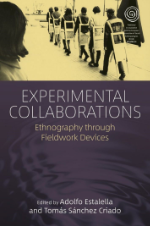 Experimental collaborations: Ethnography through fieldwork devices edited by Adolfo Estalella and Tomás Sánchez Criado
Experimental collaborations: Ethnography through fieldwork devices edited by Adolfo Estalella and Tomás Sánchez Criado
In the accounts compiled in this book, ethnography occurs through processes of material and social interventions that turn the field into a site for epistemic collaboration. Through creative interventions that unfold what we term as ‘fieldwork devices’—such as coproduced books, the circulation of repurposed data, co-organized events, authorization protocols, relational frictions, and social rhythms—anthropologists engage with their counterparts in the field in the construction of joint anthropological problematizations. In these situations, the traditional tropes of the fieldwork encounter (i.e. immersion and distance) give way to a narrative of intervention, where the aesthetics of collaboration in the production of knowledge substitutes or intermingles with participant observation. Building on this, the book proposes the concept of ‘experimental collaborations’ to describe and conceptualize this distinctive ethnographic modality.
(read the Introduction here)
“Democratic Design Experiments: Between Parliament and Laboratory,” by Thomas Binder, Eva Brandt, Pelle Ehn, and Joachim Halse in CoDesign 11:3-4 (2015): 162-65
For more than four decades, participatory design has provided exemplars and concepts for understanding the democratic potential of design participation. Despite important impacts on design methodology, participatory design has, however, been stuck in a marginal position as it has wrestled with what has been performed and accomplished in participatory practices. In this article, we discuss how participatory design may be reinvigorated as a design research programme for democratic design experiments in the light of the decentring of human-centredness and the foregrounding of collaborative representational practices offered by the ANT tradition in the tension between a parliament of things and a laboratory of circulating references.
“Figurations of Spatiality and Temporality in Participatory Design and After - Networks, Meshworks, and Patchworking,” by Kristina Lindström and Åsa Ståhl in CoDesign 11:3-4 (2015).
In recent years, many have combined actor–network theory (and after) and collective design. In this emerging field that we call participatory design and after, many have proposed and appropriated figurations such as networks, fluid, fire, thing and meshwork. In this paper, we argue that figurations do not only contribute to knowing the world, they also intervene in the becoming of worlds. This recognition of the performative character of figuration suggests that knowledge-making and world-making are inseparable, and makes it very important to be careful what figurations we imagine, articulate and use. In order to continue the work done in ANT and collective design that focuses on uncertainties, boundary-making, com- plexities and time, we propose the figuration of patchworking. What we particularly find generative with the figuration of patchworking is that it figures design as entanglements in multiple temporalities. Through the figuration of patchworking, we offer an approach that allows for understanding and working with multiple and over- lapping collectives. This means to refigure how and where to draw the boundaries of co-designing in technological societies.
The Network Lab: A proposal for design-anthropological experimental set-ups in cultural work and social research by Sissel Olander (PhD thesis)
Drawing on the metaphor of the open design laboratory and the Co-design Lab and on the work of Hans-Jörg Rheinberger and his conceptual framework for analyzing experimental research practices in the life sciences, this thesis sets out to position an experimental co-design practice on the borders of constructive design research and constructivist social research... By focusing on research activities as a network of events, always forged but never fully controlled by the researcher, the thesis highlights the critical role of methodology in research. It exposes how co-design tools and methods offer a way into an experimental engagement with the social. The account shows how the repetitive and committed work of producing a network of events, takes off from a practice rather than from conceptual and theoretical orders, and how such a practice holds the potentiality of the unknown and possible together, while at the same time the continual exploration of that same practice is a prerequisite for building a potent research machine. By juxtaposing the network with the lab the experimental research device presented in this thesis works to strike a balance between change as a phenomenon that unfolds in always already emerging networks, and change as local forms of situated difference and displacement, which cannot only be grasped within the lab but are completely dependent on the local forging and configuration of the lab to materialize and become visible.
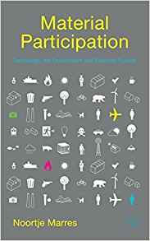 Material Participation: Technology, the Environment and Everyday Publics by Noortje Marres
Material Participation: Technology, the Environment and Everyday Publics by Noortje Marres
"There has been a lot of talk in the social sciences in recent years about the need to better account for material agencies in our understanding social practice. Much of this discussion rests on foundational empirical work that focused either on the practices of scientists and their engagements with substances and scientific apparatus in the making of scientific knowledge (e.g. Latour and Woolgar 1986), or the actions of technology and the capacity of artefacts to shape social worlds in both intended and unintended ways (e.g. Winner 1986, Bijker et al 1987). These studies helped to demonstrate how mundane objects could be said to have a politics, wrenching things from the condition of context and ascribing them a liveliness and agency that allowed them to become actors in accounts of social life. The striking move that Marres makes in this fascinating study of material participation is to turn this focus around to ask not just what are the politics of objects, but rather what are the objects and materials of contemporary politics? Specifically, Marres focuses on the political affordances of certain material artefacts in order to rethink what ‘the public’ is and the role that such publics play in political life." This book develops a fresh perspective on everyday forms of engagement, one that foregrounds the role of objects, technologies and settings in democracy. Examining a range of devices, from smart meters to eco-homes, the book sets out new concepts and methods for analyzing the relations between participation, innovation and the environment.
 Design As Future-Making edited by Susan Yelavich and Barbara Adams
Design As Future-Making edited by Susan Yelavich and Barbara Adams
Leading international designers, scholars, and critics address ways in which design is shaping the future. The contributors share an understanding of design as a practice that, with its focus on innovation and newness, is a natural ally of futurity. Ultimately, the choices made by designers are understood here as choices about the kind of world we want to live in. Design as Future-Making locates design in a space of creative and critical reflection, examining the expanding nature of practice in fields such as biomedicine, sustainability, digital crafting, fashion, architecture, urbanism, and design activism. The authors contextualize design and its affects within issues of social justice, environmental health, political agency, education, and the right to pleasure and play. Collectively, they make the case that, as an integrated mode of thought and action, design is intrinsically social and deeply political.
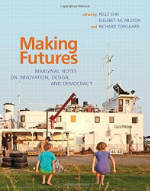 Making Futures: Marginal Notes on Innovation, Design, and Democracy edited by Pelle Ehn, Elisabet M. Nilsson, and Richard Topgaard
Making Futures: Marginal Notes on Innovation, Design, and Democracy edited by Pelle Ehn, Elisabet M. Nilsson, and Richard Topgaard
Innovation and design can start in people's everyday activities. They can encompass local services, cultural production, arenas for public discourse, or technological platforms. The approach is participatory, collaborative, and engaging, with users and consumers acting as producers and creators. It is concerned less with making new things than with making a socially sustainable future. This book describes experiments in innovation, design, and democracy, undertaken largely by grassroots organizations, non-governmental organizations, and multi-ethnic working-class neighborhoods. These stories challenge the dominant perception of what constitutes successful innovations. They recount efforts at social innovation, opening the production process, challenging the creative class, and expanding the public sphere.
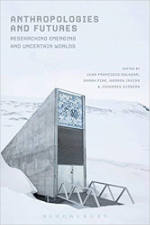 Anthropologies and Futures: Researching Emerging and Uncertain Worlds edited by Juan Francisco Salazar, Sarah Pink, Andrew Irving, and Johannes Sjöberg
Anthropologies and Futures: Researching Emerging and Uncertain Worlds edited by Juan Francisco Salazar, Sarah Pink, Andrew Irving, and Johannes Sjöberg
Anthropology has a critical, practical role to play in contemporary debates about futures. This game-changing new book presents new ways of conceptualising how to engage with a future-oriented research agenda, demonstrating how anthropologists can approach futures both theoretically and practically, and introducing a set of innovative research methods to tackle this field of research. Anthropology and Futures brings together a group of leading scholars from across the world... firmly grounded in ethnographic fieldwork experience. Taking a strong interdisciplinary approach, the authors respond to growing interest in the topic of futures in anthropology and beyond.
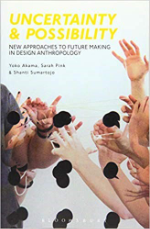 Uncertainty and Possibility: New Approaches to Future Making in Design Anthropology edited by Sarah Pink, Yoko Akama, and Shanti Sumartojo
Uncertainty and Possibility: New Approaches to Future Making in Design Anthropology edited by Sarah Pink, Yoko Akama, and Shanti Sumartojo
Uncertainty and possibility are emerging as both theoretical concepts and fields of empirical investigation, as scholars and practitioners seek new creative, hopeful and speculative modes of understanding and intervening in a world of crisis. This book offers new perspectives on the central issues of uncertainty and possibility, and identifies new research methods which take advantage of disruptive and experimental techniques. Advancing a practical agenda for future making, it reveals how uncertainty can be engaged as a generative 'technology' for understanding, researching and intervening in the world. Drawing on key themes in creative methodologies, such as making, essaying, inhabiting and attuning, chapters explore contemporary sites of practice. The book looks at maker spaces and technology design, the imaginaries of architectural design, the temporalities of built cultural heritage, and interdisciplinary making and performing.
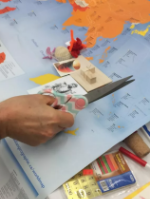 “Turning Foresight Inside Out: An Introduction to Ethnographic Experiential Futures,” Stuart Candy and Kelly Kornet in Journal of Future Studies 23:3 (March 2019)
“Turning Foresight Inside Out: An Introduction to Ethnographic Experiential Futures,” Stuart Candy and Kelly Kornet in Journal of Future Studies 23:3 (March 2019)
This article contributes to emerging hybrid design/futures practices by offering an orienting framework making images of the future more legible and concrete. The Ethnographic Experiential Futures (EXF) Cycle provides, practically, a way of inviting engagement with diverse participants, and methodologically, a generic process drawing on two traditions of foresight (ethnographic and experiential futures), with a view to promoting a more diverse and deeper array of scenarios for public consideration. The structure of the EXF Cycle is derived from hybrid efforts carried out by design/futures practitioners over some years, abstracted as scaffolding to serve future projects in a wide range of contexts.
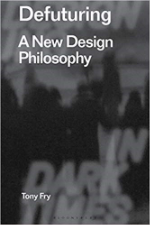 Defuturing: A New Design Philosophy (Radical Thinking in Design) by Tony Fry
Defuturing: A New Design Philosophy (Radical Thinking in Design) by Tony Fry
First published in 1999, DeFuturing: A New Design Philosophy is a prescient and powerful account of what it means to comprehend that we live in world that is taking away futures for ourselves and non-human others. Arguing that designing is doubly implicated in this process, first in its roles in helping to create the unsustainable, but second, re-thought through the lens of defuturing, as a mode of acting in the world that can help contest the negation of the world, Defuturing transforms our comprehension of designing and of how futures can be constituted. Working not through abstract theorizing but through the analysis of concrete examples, the book uses historical material on design to expose the archaeology of defuturing. Shattering the illusion that the future simply “is”, Defuturing confronts designing with the challenge of remaking while offering the elements of a new practical reasoning of design acting.
*direct download* “Design Anthropology Is Not and Cannot Be Ethnography” by Tim Ingold at the Research Network for Design Anthropology, Seminar 2, Interventionist Speculations, Copenhagen
"On the face of it, anthropology and design would seem to point in opposite directions. Anthropology is committed to observing and describing life as we find it, as it is lived by the people of different places and times. Design is committed to proposing new forms of life, never before encountered: it is prospective rather than retrospective. Surely, understanding past or present worlds is one thing; helping to create new worlds is another. Design anthropology, in these terms, sounds like a contradiction in terms. I want to argue, to the contrary, that there is no contradiction here: that both design and anthropology are inherently speculative disciplines, whose propositions nevertheless only carry force to the extent that they are grounded in a profound understanding of human lived worlds. This argument implies a double critique: on the one hand of the kind of design thinking that, in making a fetish of innovation, leans towards forms that are inherently unsustainable; and on the other hand of a kind of anthropological thinking for which even speculative intervention is done in the name of retrospective inquiry into the manifold, contextually specific particularities of life. I shall not here develop the first critique: it has been put forward many times before and has already gained considerable traction. I shall concentrate instead on the second. The kind of anthropological thinking to which I object is, of course, that which holds the be all and end all of anthropology to be ethnography."
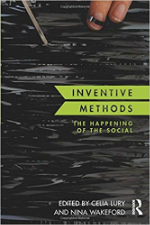 Inventive Methods: The Happening of the Social ed. by Celia Lury and Nina Wakeford
Inventive Methods: The Happening of the Social ed. by Celia Lury and Nina Wakeford
Social and cultural research has changed dramatically in the last few years in response to changing conceptions of the empirical, an intensification of interest in interdisciplinary work, and the growing need to communicate with diverse users and audiences. Methods texts, however, have not kept pace with these changes. This volume provides a set of new approaches for the investigation of the contemporary world. Building on the increasing importance of methodologies that cut across disciplines, more than twenty expert authors explain the utility of 'devices' for social and cultural research – their essays cover such diverse devices as the list, the pattern, the event, the photograph, the tape recorder and the anecdote. With a range of genres and styles of writing, each chapter presents the device as a hinge between theory and practice, ontology and epistemology, and explores whether and how methods can be inventive.
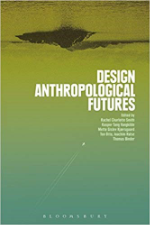 Design Anthropological Futures edited by Rachel Charlotte Smith, Kasper Tang Vangkilde, Mette Gislev Kjaersgaard, Ton Otto, Joachim Halse, and Thomas Binder
Design Anthropological Futures edited by Rachel Charlotte Smith, Kasper Tang Vangkilde, Mette Gislev Kjaersgaard, Ton Otto, Joachim Halse, and Thomas Binder
A major contribution to the field, this ground-breaking book explores design anthropology's focus on futures and future-making. Examining what design anthropology is and what it is becoming, the authors push the frontiers of the discipline and reveal both the challenges for and the potential of this rapidly growing transdisciplinary field. Divided into four sections – Ethnographies of the Possible, Interventionist Speculation, Collaborative Formation of Issues, and Engaging Things – the book develops readers' understanding of the central theoretical and methodological aspects of future knowledge production in design anthropology. Bringing together renowned scholars such as George Marcus and Alison Clarke with young experimental design anthropologists from countries such as Denmark, Sweden, Austria, Brazil, the UK, and the United States, the sixteen chapters offer an unparalleled breadth of theoretical reflections and rich empirical case studies.
(The introduction can be viewed online here. Also see all submitted papers to the Design Anthropological Futures Conference (2014-2015): Seminar 1: Ethnographies of the possible, Seminar 2: Interventionist Speculation, Seminar 3: Collaborative Formation of Issues)
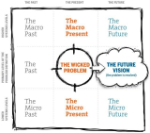 The Emerging Transition Design Approach by Terry Irwin
The Emerging Transition Design Approach by Terry Irwin
The Transition Design Framework brings together an evolving body of practices that can be used to: 1. visualize and " map " complex problems and their interconnections and interdependencies; 2. situate them within large, spatio-temporal contexts; 3. identify and bridge stakeholder conflicts and leverage alignments; 4. facilitate stakeholders in the co-creation of visions of desirable futures; 5. identify leverage points in the large problem system in which to situate design interventions. Rather than a fixed, templatised process, the Transition Design Framework provides a logic for bringing together an evolving set of practices relevant to designing for systems level change. This paper reports on how this approach is being tested on a community based project that was informed by classroom based coursework. A new, design-led approach is needed to address the complex, wicked problems confronting societies in the 21 st century (Hughes & Steffen, 2013; Jensen, 2017) and to seed and catalyse societal transitions toward more sustainable and desirable long-term futures (Porritt, 2013, pp 274-276).
 Inventing the Social ed. by Noortje Marres, Michael Guggenheim and Alex Wilkie
Inventing the Social ed. by Noortje Marres, Michael Guggenheim and Alex Wilkie
(free download)"Inventing the Social showcases recent efforts to develop new ways of knowing society that combine social research with creative practice. With contributions from leading figures in sociology, architecture, geography, design, anthropology, and digital media, the book provides practical and conceptual pointers on how to move beyond the customary distinctions between knowledge and art, and on how to connect the doing, researching and making of social life in potentially new ways. Presenting concrete projects with a creative approach to researching social life as well as reflections on the wider contexts from which these projects emerge, this collection shows how collaboration across social science, digital media and the arts opens up timely alternatives to narrow, instrumentalist proposals that seek to engineer behaviour and to design community from scratch. To invent the social is to recognise that social life is always already creative in itself and to take this as a starting point for developing different ways of combining representation and intervention in social life."
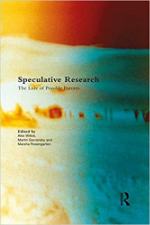 Speculative Research: The Lure of Possible Futures edited by Alex Wilkie, Martin Savransky, and Marsha Rosengarten
Speculative Research: The Lure of Possible Futures edited by Alex Wilkie, Martin Savransky, and Marsha Rosengarten
Is another future possible? So called ‘late modernity’ is marked by the escalating rise in and proliferation of uncertainties and unforeseen events brought about by the interplay between and patterning of social–natural, techno–scientific and political-economic developments. The future has indeed become problematic. The question of how heterogeneous actors engage futures, what intellectual and practical strategies they put into play and what the implications of such strategies are, have become key concerns of recent social and cultural research addressing a diverse range of fields of practice and experience. Exploring questions of speculation, possibilities and futures in contemporary societies, Speculative Research responds to the pressing need to not only critically account for the role of calculative logics and rationalities in managing societal futures, but to develop alternative approaches and sensibilities that take futures seriously as possibilities and that demand new habits and practices of attention, invention, and experimentation.
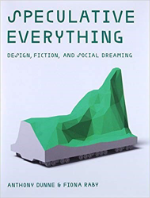 Speculative Everything: Design, Fiction, and Social Dreaming by Anthony Dunne and Fiona Raby
Speculative Everything: Design, Fiction, and Social Dreaming by Anthony Dunne and Fiona Raby
How to use design as a tool to create not only things but ideas, to speculate about possible futures? Today designers often focus on making technology easy to use, sexy, and consumable. In Speculative Everything, Anthony Dunne and Fiona Raby propose a kind of design that is used as a tool to create not only things but ideas. For them, design is a means of speculating about how things could be―to imagine possible futures. This is not the usual sort of predicting or forecasting, spotting trends and extrapolating; these kinds of predictions have been proven wrong, again and again. Instead, Dunne and Raby pose “what if” questions that are intended to open debate and discussion about the kind of future people want (and do not want). Speculative Everything offers a tour through an emerging cultural landscape of design ideas, ideals, and approaches.
(also see Cameron Tonkinwise "Transitioning to Critical Speculations about how to Govern our Cosmopolitan Societies: The Opportunity of an Interview to Clarify and Redirect" and "The Structure of Structural Change: Making a Habit of Being Alienated as a Designer" in Routledge Handbook of Sustainable Design.)
"Design Fiction: A Method Toolbox for Design Research in a Complex World" by Simon Grand and Martin Wiedmer in Design Research Society, DRS2010
Current debates on design research, and its relation to other research fields and scientific disciplines, refer back to a fundamental distinction introduced by Herb Simon (Simon, 1996 (1981)): Design and design research do not primarily focus on explaining the world as it is; they share with engineering a fundamental interest in focusing on the world as it could be. In parallel, we observe a growing interest in the science studies to interpret scientific research as a constructive and creative practice (Knorr Cetina, 1999; 2002), organized as experimental systems (Rheinberger, 2001). Design fiction is a new approach, which integrates these two perspectives, in order to develop a method toolbox for design research for a complex world (Bleecker, 2009; Wiedmer & Caviezel, 2009; Grand 2010).
"Rescuing Epistemic Objects From Speculative Design" by Carla Boserman in Diseña 14
This article explores the role of epistemic objects in speculative design, proposing an overview that goes from the origins of this practice in the ‘90s to its consolidation as a research method, through the emergence of design fiction in the last decade. In considering different critical accounts and the limits to this practice pointed out in recent years, it seeks to rescue and analyze the role of diegetic prototypes as research sites. This paper will argue that prototypes are a possible embodiment of what Rheinberger calls ‘epistemic objects’ or ‘epistemic things’. Conceived as such, these prototypes allow us for generation of knowledge by designing and to revisit the experimental character of a method that leads us to explore and materialize what we presently do not know.
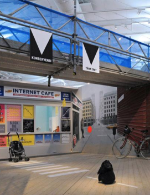 "The Critical Design Exhibition: An Epistemic Space" by Russell Gillian
"The Critical Design Exhibition: An Epistemic Space" by Russell Gillian
Situating the principles of ‘device’ in relation to that of critical design helps us to conceptualise works of critical design as assemblages (practices, objects and concepts) of experimental activity... Any critical design could therefore not be considered a static fact but more so a performative act in the here and now. It is precisely here where one sees the transition from design characterized as praxis (a will that produces a concrete effect) towards a design that inhabits the space of possible becoming... The designed outcome is not viewed as an end point in the search for a solution to a problem, but instead assumes an ‘experimental value’ which acts as an 'entrance point for critical thinking about the self evident, not only as the world could be, but rather to find a new, distant perspective on reality as it is' (Grand & Wiedmer, 2010, p.5). Consequently, the work seeks to enhance our experiences not just with what we ‘know’ and ‘understand’ but with ‘who’ we are and ‘where’ we stand"... (starting on pg.368)
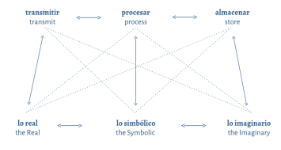 "Experimental Design as Archeological Practice" by Diego Gómez-Venegas in Diseña 12
"Experimental Design as Archeological Practice" by Diego Gómez-Venegas in Diseña 12
This article presents an approach to design which is understood as an archaeological practice; that is, an inquiry that —from the Foucauldian theories— seeks to unravel the epistemic orders embedded in the machines; to show the modes of knowing they install in culture, and in society. Thus, the archaeology of knowledge is introduced as investigative approach within the realm of human sciences and, then, as a methodology for the analysis of culture in the field of media studies, through Friedrich Kittler’s and Wolfgang Ernst’s ideas. Then, an experimental design project, a thesis of the Universidad de Chile, is commented on to exemplify the modes in which such perspective transforms the activity of design and its disciplinary categories. Finally, the text draws a methodological proposal for this design, mapping out an institutional context where this proposal can be developed in full.
Matters of Concern All The Way Down by Isabelle Stengers
"The science wars were both predictable and unfortunate. It was very quickly forgotten that the crucial question was the general, unilateral authority of objectification conquering the world. Defining what really matters and what may - even must - be discarded. Blessing in the name of reason the destruction of innumerable other ways of relating, knowing, feeling and interpreting. It became a war between masters—that is a war waged on an epistemological ground about the conditions of valid knowledge... I am obviously not the only one to have kept alive the memory of the science wars as that of a disaster but also to have accepted it as a call for radical rethinking... Invoking the way in which the critical, deconstructivist argument against what scientists call ‘matter of facts’ has been captured by those whom we now call ‘merchants of doubt’, Latour asked: ‘Can we devise another powerful descriptive tool that deals this time with matters of concern and whose import then will no longer be to debunk but to protect and care... Is it really possible to transform the critical urge in the ethos of someone who adds reality to matters of fact and not subtract reality?’ (‘Why’, 232)... Adding reality, that of the voiceless ones, is indeed what Deborah Bird Rose, Thom van Dooren, Anna Tsing or Lesley Green, to quote but a few, are doing. And reality in this case does not refer to something we can argue about, or argue for, promote or advocate as its spokespersons. The added reality is entangling. Its efficacy is tentacular, to use Donna Haraway’s term. It demands allowing oneself to be touched and be forced to think by the touching, facing the danger which goes with it, to be grasped and captured."
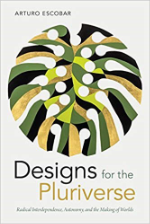 Designs for the Pluriverse: Radical Interdependence, Autonomy, and the Making of Worlds by Arturo Escobar
Designs for the Pluriverse: Radical Interdependence, Autonomy, and the Making of Worlds by Arturo Escobar
In Designs for the Pluriverse Arturo Escobar presents a new vision of design theory and practice aimed at channeling design's world-making capacity toward ways of being and doing that are deeply attuned to justice and the Earth. Noting that most design—from consumer goods and digital technologies to built environments—currently serves capitalist ends, Escobar argues for the development of an “autonomous design” that eschews commercial and modernizing aims in favor of more collaborative and placed-based approaches. Such design attends to questions of environment, experience, and politics while focusing on the production of human experience based on the radical interdependence of all beings. Mapping autonomous design’s principles to the history of decolonial efforts of indigenous and Afro-descended people in Latin America, Escobar shows how refiguring current design practices could lead to the creation of more just and sustainable social orders.
(Arturo Escobar's "Notes On The Ontology of Design" is available to read online)
"Autonomous design and the emergent transnational critical design studies field" by Arturo Escobar in Strategic Design Research Journal, 11(2): 139-146
This paper examines the seeming repositioning of design as a central domain of thought and action concerned with the meaning and production of socionatural life. It suggests that critical design studies are being actively reconstituted –perhaps more clearly than many social and human sciences and professional fields—as a key space for thinking about life and its defense from increasingly devastating anthropogenic forces. There is a hopeful recognition of the multidimensional character of design as material, cultural, epistemic, political, and ontological, all at once. Design, in short, is being acknowledged as a decisive world-making practice, even if often found wanting in this regard. The mood seems to be settling in, at least among a small but possibly growing number of design theorists and practitioners, for playing a more self-aware, and constructive, role in the making and unmaking of worlds.
"What Is at Stake with Decolonizing Design? A Roundtable" by Schultz et al in Design and Culture 10:1 (2018)
"This roundtable was conducted by the eight founding members of Decolonising Design Group in October 2017, using an online messaging platform. Each member approached design and decoloniality from different yet interrelating viewpoints, by threading their individual arguments with the preceding ones. The piece thus offers and travels through a variety of subject matter including politics of design, artificiality, modernity, Eurocentrism, capitalism, Indigenous Knowledge, pluriversality, continental philosophy, pedagogy, materiality, mobility, language, gender oppression, sexuality, and intersectionality."
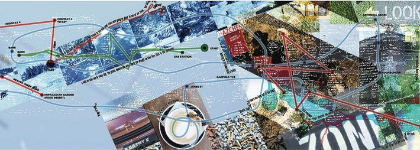 "Mapping Indigenous Futures: Decolonising Techno-Colonising Designs" by Tristan Schultz in Strategic Design Research Journal 11(2)
"Mapping Indigenous Futures: Decolonising Techno-Colonising Designs" by Tristan Schultz in Strategic Design Research Journal 11(2)
This paper provides a critical interrogation of the consequences of modernity and coloniality, particularly in an Aboriginal Australian context, with focus on the accelerating speed of socio-communicative technological change. I argue from a perspective of being Australian with both Aboriginal and European heritage, with a designing politics for human 'sustainment' (Fry, 2009). Five provocations are provided that illustrate ways in which the seductive and repressive nature of modernity/coloniality enables socio-communicative technologies to increasingly eliminate groups' capacities to imagine decolonising being-human. I summarise ways in which I apply learnings surrounding decolonising design modes of listening and comprehending that can contribute to help groups think, talk and map their situatedness among this phenomenon and mobilise decolonising options for their own worlds.
"Countering Epistemic Guardianship with Epistemic Sovereignty through the Land" by Brian Yazzie Burkhart in the Journal of Native American and Indigenous Philosophy
...Speaking of a human intertwining with land, where land is a being and a relative, triggers the operations of epistemic guardianship within the settler colonial epistemologies of ignorance... Epistemic guardianship functions to assimilate or eradicate forms of knowledge that exist outside or are seen to exist outside of the limits of knowledge set by the dominant discourse of the settler state... often exclud[ing] Indigenous ways of knowing in the process of attempting to be inclusive of and respectful of Indigenous ways of knowing... Epistemic guardianship, from the perspective of epistemic sovereignty, is not corrected by an error theory that will guide those who operate under epistemic guardianship to contexts where knowledge of Indigenous people or even the production of Indigenous knowledge in a settler context can be achieved. In part this is because epistemic sovereignty is part of the process by which Indigenous knowledge is created whether there is epistemic guardianship or not. Epistemic sovereignty is not merely a decolonial tool but an Indigenous understanding of the appropriate context for the production of knowledge in the first place.
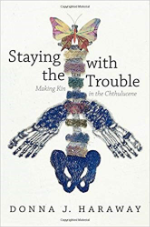 Staying with the Trouble: Making Kin in the Chthulucene (Experimental Futures) by Donna Haraway
Staying with the Trouble: Making Kin in the Chthulucene (Experimental Futures) by Donna Haraway
n the midst of spiraling ecological devastation, multispecies feminist theorist Donna J. Haraway offers provocative new ways to reconfigure our relations to the earth and all its inhabitants. She eschews referring to our current epoch as the Anthropocene, preferring to conceptualize it as what she calls the Chthulucene, as it more aptly and fully describes our epoch as one in which the human and nonhuman are inextricably linked in tentacular practices. The Chthulucene, Haraway explains, requires sym-poiesis, or making-with, rather than auto-poiesis, or self-making. Learning to stay with the trouble of living and dying together on a damaged earth will prove more conducive to the kind of thinking that would provide the means to building more livable futures. Theoretically and methodologically driven by the signifier SF—string figures, science fact, science fiction, speculative feminism, speculative fabulation, so far—Staying with the Trouble further cements Haraway's reputation as one of the most daring and original thinkers of our time.
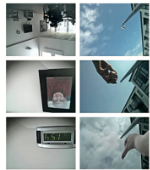 “Speculative Prototypes and Alien Ethnographies: Experimenting with Relations Beyond the Human” by Tau Ulv Lenskjold and Li Jönsson in Diseña 11 (2017)
“Speculative Prototypes and Alien Ethnographies: Experimenting with Relations Beyond the Human” by Tau Ulv Lenskjold and Li Jönsson in Diseña 11 (2017)
"This article concerns the role of speculative design prototypes as a means of intervening into everyday life contexts in order to explore, and possibly enable, new kinds of relations between humans and non-human beings. By addressing a human de-centring through design, the aim is to explore what kind of new possibilities might arise when design speculation meets a practice of doing what can be called an ‘alien ethnography’."
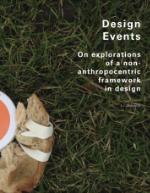 Design Events: On explorations of a non- anthropocentric framework in design by Li Jönsson (PhD thesis)
Design Events: On explorations of a non- anthropocentric framework in design by Li Jönsson (PhD thesis)
In this thesis events are introduced as a way of focusing away from traditional approaches to the objects of design. By that, the aim is to find better ways and give more justice to the interchanges and mutual transformations going on between various material bodies such as nonhuman artefacts and humans. But how do we actually go about this? How can we afford these ‘nonhuman others’ the opportunity to give us the chance to talk differently about them? How do we move the static design objects to becoming moving entangled things? I argue that through an event framing we have to pay particular attention to how objects and materials have powers of their own far beyond the intention of the designer and thus allow us to keep the doors open for potentialities. In other words, I suggest the event to be a non-anthropocentric design approach that supports us in practicing ways of placing the hybrid collective in centre. By theoretically drawing primarily from Science & Technology Studies (STS), feminist theory and from traditions of experimental design I explore what particularities such an event framing can help bring to the table through a series of practice driven design projects that encounters issues such as energy, ageing and co-habitation through the design experiments Watt-lite, Invite! and Urban Animals & Us.
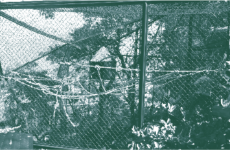 "Pedagogical Impugnation: Interspecies Prototyping and Cosmopolitical Encounters" by Pablo Hermansen and Martin Tironi in Diseña 12
"Pedagogical Impugnation: Interspecies Prototyping and Cosmopolitical Encounters" by Pablo Hermansen and Martin Tironi in Diseña 12
"In this article we will analyze the epistemological displacements experienced in the Interaction Design Workshop of the Design School of the Pontificia Universidad Católica de Chile during an intervention carried out in the first semester of 2016 at the National Zoo of Chile (NZC). First, we describe the process of transformation of the pedagogical practices raised in the Design School at the beginning of the 21st Century and the adoption of the ethnographic turn; then, we show how the intervention in the NZC became an impugnation to the epistemological and methodological frameworks of user-centered design and problem-solving design. Through the notion of ’cosmopolitical encounters’, inspired by the work of the philosopher Isabelle Stengers, and the interspecies experience in the NZC, we conclude that prototyping is a pedagogical tool that allows us to question epistemologies and hegemonic methods, encouraging the possibility of developing a ’cosmopolitical design’."
 “Ecologizing, Decolonizing: An Artefactual Perspective,” by Mathieu Avila at NORDES 2017, 7th Nordic Design Research Conference
“Ecologizing, Decolonizing: An Artefactual Perspective,” by Mathieu Avila at NORDES 2017, 7th Nordic Design Research Conference
In this paper I present a design project developed in Córdoba, Argentina, entitled ‘Spices-Species’. Through this case study, I discuss the possibility of designing using two decolonial strategies — "objectivity (or truth) in parenthesis" and " being where one does and thinks"— that can lead to delinking, on a micropolitical scale, from colonial social patterns as well as reconnecting humans with natural processes and beings to which they are detached by means of devices. The paper suggests that these decolonial strategies, combined with the performance of designed artefacts may help to acknowledge not only human diversity, but also the multiple and diverse nonhuman beings that conform and participate in different localities.
